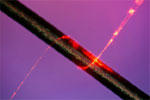Silica nanowires
Silica nanowires: manipulating light at the nanoscale,
at
Asia-Pacific Optical Communications 2007 (Wuhan, China),
Saturday, November 3, 2007
Nonlinear optics at the nanoscale,
at
Research Seminar, University of Twente (Enschede, The Netherlands),
Friday, June 12, 2009:
Silica Nanowires for Microphotonic Devices,
at
NSEC AP298 Seminar, Harvard University (Cambridge, MA),
Monday, April 18, 2011:
Nonlinear optics at the nanoscale,
at
2013 Biannual Meeting of Norwegian Physical Society (Bergen, Norway),
Friday, August 9, 2013:
Wrapping light around a hair,
at
Physics Colloquium, University of Missouri-Rolla (Rolla, MO),
Thursday, October 21, 2004:
Wrapping light around a hair,
at
Physics Colloquium, Northwestern University (Evanston, IL),
Friday, November 18, 2005:
Ultrashort laser pulses and nanoscale optics,
at
Course on Frontier Developments in Optics and Spectroscopy, Centro Ettore Majorana (Erice, Italy),
Tuesday, June 19, 2007:
Nonlinear optics at the nanoscale,
at
15th International Conference on Luminescence and Optical Spectroscopy of Condensed Matter (Lyon, France),
Monday, July 7, 2008:
Nonlinear optics at the nanoscale,
at
Institute of Physics in Ireland 2009/2010 Lecture, Trinity College (Dublin, Ireland),
Friday, March 12, 2010:
Silica Nanowires Part I: Optical properties,
at
Royal Society Seminar on Science and Technology of Silica Nanowires, Kavli Institute of the Royal Society (Milton Keynes, United Kingdom),
Thursday, November 8, 2012:
. 2012. “Integrated TiO2 resonators for visible photonics.” Opt. Lett., 37, Pp. 539–541. Publisher's VersionAbstract
. 2005. “Self-modulated taper drawing of silica nanowires.” Nanotechnology, 16, Pp. 1445–1448. Publisher's VersionAbstract
. 2005. “Nanowiring Light.” In . Optical Fiber Communication Conference 2005. Publisher's VersionAbstract
. 2005. “Waveguide bends from nanometric silica wires.” In . Nanophotonics, Nanostructure, and Nanometrology. Publisher's VersionAbstract
. 2003. “Subwavelength-diameter silica wires for low-loss optical wave guiding.” Nature, 426, Pp. 816–819. Publisher's VersionAbstract
 We developed a process for fabricating silica nanowires with a diameter of only one thousandth the diameter of a hair. Although significantly narrower than the wavelength of light, these nanowires can act as "rails" for light and are promising building blocks for future microphotonic devices.
We developed a process for fabricating silica nanowires with a diameter of only one thousandth the diameter of a hair. Although significantly narrower than the wavelength of light, these nanowires can act as "rails" for light and are promising building blocks for future microphotonic devices.